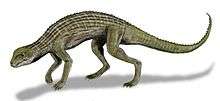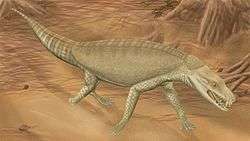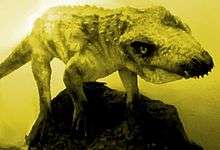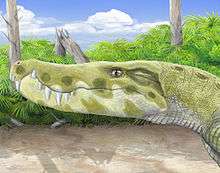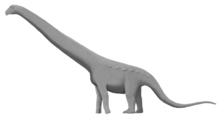Adamantina Formation
The Adamantina Formation is a geological formation in the Bauru Basin of western São Paulo state, in southeastern Brazil.
| Adamantina Formation Stratigraphic range: Late Campanian-Early Maastrichtian ~72.1–68 Ma | |
|---|---|
| Type | Geological formation |
| Unit of | Bauru Group |
| Underlies | Uberaba Formation |
| Overlies | Santo Anastacio, Caiuá & Araçatuba Formations |
| Lithology | |
| Primary | Sandstone, calcrete |
| Other | Mudstone, siltstone, conglomerate, coal |
| Location | |
| Coordinates | 21.6°S 50.1°W |
| Approximate paleocoordinates | 25.8°S 33.1°W |
| Region | |
| Country | |
| Extent | Bauru Basin, Paraná Basin |
| Type section | |
| Named for | Adamantina |
 Adamantina Formation (Brazil) | |
Its strata date back to the Late Cretaceous epoch of the Cretaceous Period, during the Mesozoic Era. The formation is part of the Bauru Group in the northeastern Paraná Basin.
Geology
Dinosaur remains are among the fossils that have been recovered from the Adamantina Formation.[1] According to some studies,[2][3][4][5] the Adamantina Formation dates from the Turonian to the Santonian stage (90-83.5 million years ago) of the late Cretaceous, other studies have found a much younger age - Campanian to Maastrichtian (83.5-66 million years ago) of the late Cretaceous.[6][7]
More recent studies lean into the latter category[8] and an unpublished article abstract revealed at the Society of Vertebrate Paleontology in 2017 also argues that the Allen Formation, Loncoche, and Los Alamitos Formation are all contemporaries and are no later than 72.1Ma in age.[9] A zircon was found dating to 85.2 ± 2.7 Ma so this represents a maximum age.[10]
Geological setting
During the Early Jurassic, the supercontinent Pangea started to drift apart due to the breakup of Gondwana and Laurasia.[11] The breakup of Gondwana caused the formation of the large Parana Basin. This basin has a size of ~1,100,000km2 and can be found not only in Brazil but also in Paraguay, Uruguay, and Argentina.[12] The separation of the supercontinent and the breakup of Brazil and Africa was accompanied by volcanism that caused large eruptions of flood basalts. These volcanic rocks formed the Serra Geral Formation which underlies the deposits of the Bauru Group.[12]
The Bauru Basin is a trough that, as Miall (1990) argues,[13] evolved due to “thermo-mechanical subsidence” during the Late Cretaceous, probably due to the breakup of Africa and India.[11] The sediments reach a thickness of up to ~300 m and consist mainly of siliciclastic sediments.[14] The Bauru Group can be subdivided into five different formations [12][15][16][17] from bottom to top: Caiua, Santo Anastacio, Adamantina, and Uberaba. Not all formations are equally well represented in the different states and differences occur according their sedimentary composition and therefore also in their naming.[12]
Vertebrate paleofauna
Crurotarsans
Color key
|
Notes Uncertain or tentative taxa are in small text; |
| Crocodylomorphs of the Adamantina Formation | ||||||
|---|---|---|---|---|---|---|
| Genus | Species | Location | Stratigraphic position | Material | Notes | Images |
|
A. navae |
Six specimens and several isolated bone remains. |
| ||||
|
A. arrudai |
A notosuchian | |||||
|
B. franciscoi |
||||||
|
B. albertoi[7] |
||||||
|
B. pachechoi[21] |
A baurusuchid | |||||
|
B. salgadoensis[21] |
A baurusuchid | |||||
|
B. pachecoi[21] |
||||||
|
C. paulistanus |
||||||
|
C. dinizi |
A baurusuchid | |||||
|
C. pricei |
A sphagesaurid | |||||
|
R. paulistanus |
Known from teeth, splenials and dentaries. |
a member of itasuchidae, previously known as "Goniopholis" paulistanus | ||||
|
M. amarali[21] |
Very common. Several specimens - juvenile and adults – with skull articulated to skeleton, and many isolated materials. Eggs clutches, eggshells and coprolites was found also. |
A notosuchian | ||||
|
M. robustus[25] |
A notosuchian | |||||
|
M. arrudacamposi |
||||||
|
M. luziae |
A notosuchian | |||||
|
S. huenei[21] |
A sphagesaurid | |||||
|
S. montealtensis[6] |
A sphagesaurid | |||||
|
S. maxhechti |
A baurusuchid | |||||
Ornithodirans
Indeterminate dinosaur remains are known from the formation.[1]
| Dinosaurs of the Adamantina Formation | ||||||
|---|---|---|---|---|---|---|
| Genus | Species | Location | Stratigraphic position | Material | Notes | Images |
|
Abelisauridae[28] |
Indeterminate |
"fragment of rt. premaxilla and a tooth" |
| |||
|
A. mezzalirai |
||||||
|
A. maximus |
"Single partially articulated skeleton." |
|||||
|
"A." brasiliensis |
"Postcranial remains."[31] |
|||||
|
G. faustoi |
"Partial postcranial skeleton."[32] |
|||||
|
M. topai |
||||||
|
P. nevesi |
5 incomplete teeth, 7 caudal vertebrae, part of right pubis, right tibia, and an articulation of the right fibula. The largest known abelisaurid. |
|||||
|
Unenlagiinae indet.[34] |
A single dorsal vertebra. |
|||||
Mammals
Eutheria incertae sedis, Brasilestes (tribosphenida incertae sedis),[35] gondwanatheres and meridiolestidans.[36]
See also
- Geologic formations of Brazil
- List of dinosaur-bearing rock formations
- Paleontological sites of Brazil
- Asencio Formation
References
- Weishampel, David B; et al. (2004). "Dinosaur distribution (Late Cretaceous, South America)." In: Weishampel, David B.; Dodson, Peter; and Osmólska, Halszka (eds.): The Dinosauria, 2nd, Berkeley: University of California Press. Pp. 600-604. ISBN 0-520-24209-2.
- Turner, A.H.; Calvo, J.O. (2005). "A new sebecosuchian crocodyliform from the Late Cretaceous of Patagonia". Journal of Vertebrate Paleontology. 25 (1): 87–98. doi:10.1671/0272-4634(2005)025[0087:ANSCFT]2.0.CO;2.
- Nava, William R.; Agustín G. Martinelli (2011). "A new squamate lizard from the Upper Cretaceous Adamantina Formation (Bauru Group), São Paulo State, Brazil" (PDF). Anais da Academia Brasileira de Ciências. 83 (1): 291–299. doi:10.1590/S0001-37652011000100017. ISSN 0001-3765. PMID 21437386.
- Turner, A.H.; Sertich, J.W. (2010). "Phylogenetic history of Simosuchus clarki (Crocodyliformes: Notosuchia) from the Late Cretaceous of Madagascar". Journal of Vertebrate Paleontology. 30 (6, Memoir 10): 177–236. doi:10.1080/02724634.2010.532348.
- Ismar De Souza Carvalho; Vicente De Paula Antunes Teixeira; Mara Lúcia Da Fonseca Ferraz; et al. (2011). "Campinasuchus dinizi gen. et sp. nov., a new Late Cretaceous baurusuchid (Crocodyliformes) from the Bauru Basin, Brazil" (PDF). Zootaxa. 2871: 19–42. doi:10.11646/zootaxa.2871.1.2.
- Marco Brandalise de Andrade; Reinaldo J. Bertini (2008). "A new Sphagesaurus (Mesoeucrocodylia: Notosuchia) from the Upper Cretaceous of Monte Alto City (Bauru Group, Brazil), and a revision of the Sphagesauridae". Historical Biology. 20 (2): 101–136. doi:10.1080/08912960701642949.
- Paulo Miranda Nascimento; Hussam Zaher (2010). "A new species of Baurusuchus (Crocodyliformes, Mesoeucrocodylia) from the Upper Cretaceous of Brazil, with the first complete postcranial skeleton described from the family Baurusuchidae" (PDF). Papéis Avulsos de Zoologia. 50 (21): 323‑361. doi:10.1590/s0031-10492010002100001.
- Brusatte, Stephen L.; Candiero, Carolos R.A.; Simbras, Felipe M. (2017). "The Last Dinosaurs of Brazil: The Bauru Group and its implications for the end of the Cretaceous mass extinction". Anias de Academia Brasileira de Ceincias. 89 (3): 1465–1485. doi:10.1590/0001-3765201720160918. PMID 28954171.
- "AGE OF THE ADAMANTINA FORMATION, UPPER BAURU GROUP, LATE CRETACEOUS, BRAZIL".
- Castro, Mariela C.; Goin, Francisco J.; Ortiz-Jaureguizar, Edgardo; Vieytes, E. Carolina; Tsukui, Kaori; Ramezani, Jahandar; Batezelli, Alessandro; Marsola, Júlio C. A.; Langer, Max C. (2018-05-01). "A Late Cretaceous mammal from Brazil and the first radioisotopic age for the Bauru Group". Royal Society Open Science. 5 (5): 180482. Bibcode:2018RSOS....580482C. doi:10.1098/rsos.180482. ISSN 2054-5703. PMC 5990825. PMID 29892465.
- Rabassa, J. (2014). Some concepts on Gondwana landscapes: long-term landscape evolution, genesis, distribution and age. In Gondwana Landscapes in southern South America (pp. 9-46). Springer Netherlands.
- Goldberg, K.; Garcia, A. J. (2000). "Palaeobiogeography of the Bauru Group, a dinosaur-bearing Cretaceous unit, northeastern Paraná Basin, Brazil". Cretaceous Research. 21 (2): 241–254. doi:10.1006/cres.2000.0207.
- Miall, A. D. (1990). Principles of sedimentary basin analysis (Vol. 633, p. 499). New York: Springer-Verlag.
- Candeiro, C. R. A.; Abranches, C. T.; Abrantes, E. A.; Avilla, L. D. S.; Martins, V. C.; Moreira, A. L.; Bergqvist, L. P. (2004). "Dinosaurs remains from western São Paulo state, Brazil (Bauru Basin, Adamantina Formation, Upper Cretaceous)". Journal of South American Earth Sciences. 18 (1): 1–10. doi:10.1016/j.jsames.2004.08.004.
- Soares, P. C.; Landim, P. M. B.; Fulfaro, V. J.; Neto, A. S. (1980). "Ensaio de caracterização estratigráfica do Cretáceo no estado de São Paulo: Grupo Bauru". Revista Brasileira de Geociências. 10 (3): 177–185.
- Souza Jr, J. J. (1984). O Grupo Bauru na porcao mais setentrional da Bacia Sedimentar do Paraná. In 33 Congresso Brasileiro de Geologia, Rio de Janeiro (Vol. 2, pp. 944-957).
- Dias-Brito, D., Musacchio, E. A., de Castro, J. C., Maranhão, M. S. A. S., Suárez, J. M., & Rodrigues, R. (2001). Grupo Bauru: uma unidade continental do Cretáceo no Brasil-concepções baseadas em dados micropaleontológicos, isotópicos e estratigráficos. Revue de Paléobiologie, 20(1), 245-304.
- Nobre, Pedro Henrique; Carvalho, Ismar de Souza (2006). "Adamantinasuchus navae: A new Gondwanan Crocodylomorpha (Mesoeucrocodylia) from the Late Cretaceous of Brazil" (PDF). Gondwana Research. 10 (3–4): 370–378. Bibcode:2006GondR..10..370N. doi:10.1016/j.gr.2006.05.008. Archived from the original (PDF) on 2011-07-06.
- Marinho, Thiago S.; Carvalho, Ismar S. (2009). "An armadillo-like sphagesaurid crocodyliform from the Late Cretaceous of Brazil". Journal of South American Earth Sciences. 27 (1): 36–41. Bibcode:2009JSAES..27...36M. doi:10.1016/j.jsames.2008.11.005.
- Fabiano Vidoi Iori; Karina Lucia Garcia (2012). "Barreirosuchus franciscoi, um novo Crocodylomorpha Trematochampsidae da Bacia Bauru, Brasil". Revista Brasileira de Geociências. 42 (2): 397–410. doi:10.5327/z0375-75362012000200013.
- Carvalho, Ismar de Souza; Campos, Antonio de Celso Arruda; Nobre, Pedro Henrique (2005). "Baurusuchus salgadoensis, a new Crocodylomorpha from the Bauru Basin (Cretaceous), Brazil" (PDF). Gondwana Research. 8 (1): 11–30. Bibcode:2005GondR...8...11C. doi:10.1016/S1342-937X(05)70259-8. Archived from the original (PDF) on 2010-09-21.
- Fabiano V. Iori; Ismar S. Carvalho (2011). "Caipirasuchus paulistanus, a new sphagesaurid (Crocodylomorpha, Mesoeucrocodylia) from the Adamantina Formation (Upper Cretaceous, Turonian–Santonian), Bauru Basin, Brazil". Journal of Vertebrate Paleontology. 31 (6): 1255–1264. doi:10.1080/02724634.2011.602777.
- Alexander W. A. Kellner; Diogenes A. Campos; Douglas Riff; Marco Brandalise de Andrade (2011). "A new crocodylomorph (Sphagesauridae, Notosuchia) with horn-like tubercles from Brazil". Zoological Journal of the Linnean Society. 163 (s1): S57–S65. doi:10.1111/j.1096-3642.2011.00712.x.
- André E. Piacentini Pinheiro; Paulo Victor Luiz Gomes da Costa Pereira; Rafael G. de Souza; Arthur S. Brum; Ricardo T. Lopes; Alessandra S. Machado; Lílian P. Bergqvist; Felipe M. Simbras (2018). "Reassessment of the enigmatic crocodyliform "Goniopholis" paulistanus Roxo, 1936: Historical approach, systematic, and description by new materials". PLOS ONE. 13 (8): e0199984. Bibcode:2018PLoSO..1399984P. doi:10.1371/journal.pone.0199984. PMC 6070184. PMID 30067779.
- Pedro Henrique Nobre; Ismar de Souza Carvalho; Felipe Mesquita de Vasconcellos; Willian Roberto Nava (2007). "Mariliasuchus robustus, a new Crocodylomorpha (Mesoeucrocodylia) from the Bauru Basin, Brazil" (PDF). Anuário do Instituto de Geociências. 30 (1): 38–49. ISSN 0101-9759.
- Ismar de Souza Carvalho; Felipe Mesquita de Vasconcellos; Sandra Aparecida Simionato Tavares (2007). "Montealtosuchus arrudacamposi, a new peirosaurid crocodile (Mesoeucrocodylia) from the Late Cretaceous Adamantina Formation of Brazil" (PDF). Zootaxa. 1607: 35–46. doi:10.11646/zootaxa.1607.1.3.
- Iori, F.V.; Carvalho, I.S. (2009). "Morrinhosuchus luziae, um novo Crocodylomorpha Notosuchia da Bacia Bauru, Brasil". Revista Brasileira de Geociências. 39 (4): 717–725. doi:10.25249/0375-7536.2009394717725. Archived from the original on 2011-07-06. Retrieved 2010-08-21.
- Méndez, Ariel H.; Novas, Fernando E.; Iori, Fabiano V. (2014). "New record of abelisauroid theropods from the Bauru Group (Upper Cretaceous), São Paulo State, Brazil". Revista Brasileira de Paleontologia. 17 (1): 23–32. doi:10.4072/rbp.2014.1.03.
- Santucci, R.A; Bertini, R.J. (2006). "A new titanosaur from western São Paulo State, Upper Cretaceous Bauru Group, south-east Brazil" (PDF). Palaeontology. 49 (1): 171–185. doi:10.1111/j.1475-4983.2005.00527.x. hdl:11449/33993.
- Rodrigo M. Santucci; Antonio C. de Arruda-Campos (2011). "A new sauropod (Macronaria, Titanosauria) from the Adamantina Formation, Bauru Group, Upper Cretaceous of Brazil and the phylogenetic relationships of Aeolosaurini" (PDF). Zootaxa. 3085: 1–33. doi:10.11646/zootaxa.3085.1.1.
- "Table 13.1," in Weishampel, et al. (2004). Page 270.
- "Table 13.1," in Weishampel, et al. (2004). Page 269.
- Kellner, A.W.A.; Campos, D.A.; Azevedo, S.A.K.; et al. (2006). "On a new titanosaur sauropod from the Bauru Group, Late Cretaceous of Brazil". Boletim do Museu Nacional (Geologia). 74: 1–31.
- Candeiro, C. R. A.; Cau, A.; Fanti, F.; Nava, W. R.; Novas, F. E. (2012). "First evidence of an unenlagiid (Dinosauria, Theropoda, Maniraptora) from the Bauru Group, Brazil". Cretaceous Research. 37: 223–226. doi:10.1016/j.cretres.2012.04.001.
- Castro, Mariela C.; Goin, Francisco J.; Ortiz-Jaureguizar, Edgardo; Vieytes, E. Carolina; Tsukui, Kaori; Ramezani, Jahandar; Batezelli, Alessandro; Marsola, Júlio C. A.; Langer, Max C. (2018). "A Late Cretaceous mammal from Brazil and the first radioisotopic age for the Bauru Group". Royal Society Open Science. 5 (5): 180482. Bibcode:2018RSOS....580482C. doi:10.1098/rsos.180482. PMC 5990825. PMID 29892465.
- Zofia Kielan-Jaworowska; Richard L. Cifelli; Zhe-Xi Luo (2004). "Chapter 7: Eutriconodontans". Mammals from the Age of Dinosaurs: origins, evolution, and structure. New York: Columbia University Press. pp. 216–248. ISBN 0-231-11918-6.
